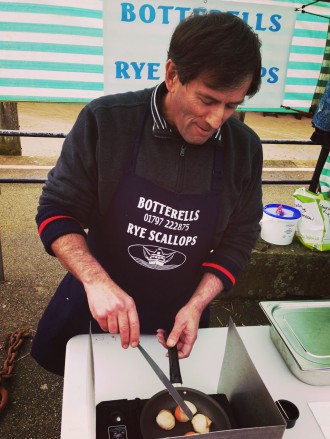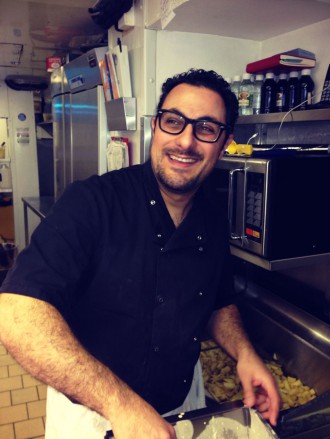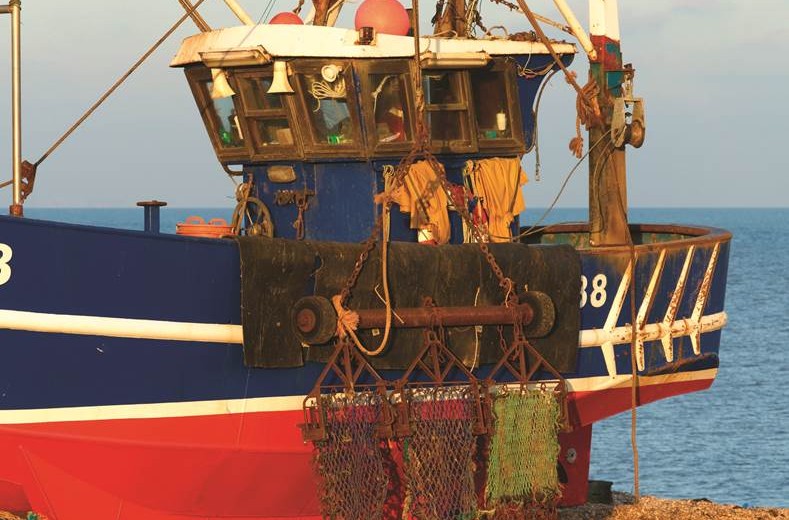Keeping afloat
Rye’s annual Scallop Festival celebrates a vital part of this pretty town’s beleaguered fishing industry, says Kate Colquhoun.

The eight-mile sweep of Camber Sands stretches along Kent’s south-eastern corner, backed by the misty salt marshes. The skies are vast, and on a clear day the coast of France appears as a fine charcoal line etched on the horizon. Water is everywhere: the Channel, the bay and the ditches and canals that bisect the marshes all magnify the light – making the area a haven both for wildfowl and artists. Overhead, the mournful shrieks of the seagulls are unceasing. Clouds of gulls dip and rise in the wake of the fishing boats returning on the high tide to the Quay at Rye.
The fishermen on these small under 10-metre boats represent the front line of the industry for which Hugh Fearnley-Whittingstall went into battle with his Fish Fight, deriding the quotas that lead to fish of the wrong size or sort being thrown overboard to perish. He is right: we eat so little fish that cod, salmon and tuna have become our stalwarts while gurnard, huss, dace and the like remain unpopular. Much from here is therefore exported, boosting the amount of fish available to our continental cousins while diminishing UK profits. Of the 51 fish species in Rye Bay, less than 20 are eaten.
Further, these local fishermen despair at the prohibition against throwing guts overboard or using them for bait. Absurdly, they must go to landfill and whole fish bait must be purchased. Further regulations make it impossible to take their sons or daughters on board to give them a taste of the job; training must be paid for and the young are losing interest. On land, spot checks on the size, type and quantity of fish by local and national regulatory bodies interrupt the day, and monthly fish quotas (which cannot be carried over if not fulfilled) can be drastically cut mid-term without warning.
Fearnley-Whittingstall made an important point, but change will not come fast. In the meantime the fishermen struggle and here, from November to May, scallops are helping them to survive.
On steeply rising ground, Rye lies to the west of Camber, one of the medieval Cinque Ports, its church spire providing a beacon for fishermen as it has for centuries. In medieval times, Rye Bay fish (herring, mackerel, cod, sole, plaice and whiting) were reserved for the king’s table, and the area remains a foodie haven where those in the know flock for Romney Marsh lamb, local cheeses, fresh fish and the fruit and vegetables that prosper in the gentle southern fields and orchards. Mid-week in February, though, the town is empty; the staff kicking their heels in the restaurants have a beleaguered air.
Rye’s scallop festival, now in its ninth year, was conceived not only to showcase one of the area’s most delicate and delicious harvests but to kick-start the tourist season with a 10-day programme of cooking demonstrations and courses, tastings and menus packed with scallops cooked every which way – from delicate Thai-style with ginger to battered and deep-fried.
Free-moving scallops – bivalve molluscs found in all the world’s oceans – do not attach themselves to ropes or rocks like mussels or oysters, and their white flesh (or muscle) and coral roes are protected by distinctive fan-shaped shells, the ancient emblem of St James. They are the pilgrim mussel, the coquille St Jacques, packed with vitamin B12 and a rich source of omega 3 fatty acids, potassium and magnesium.
In other words, they are great for your cardiovascular health; and they also deliver selenium, helping to neutralise the negative effects of free radicals.
With taste rather than health uppermost in most people’s minds, around 15,000 Rye Bay scallops are served up during the festival – although that number may be curtailed somewhat this year due to the bad weather at the start of the week keeping boats in port. Hundreds more are bought, bagged and carried home by the weekend customers queuing at Botterells’ stall on Simmons Quay.
The big boats operating out of Shoreham are at sea for several days, while Rye’s small boats return daily, guaranteeing that the scallops are sold within hours of being caught. Gently cooked by chefs, they might be paired with chorizo, black pudding, chilli or lime. Out on the boats, though, breakfast bacon yields just enough salty fat to fry them golden in minutes. Another fisherman’s recipe suggests poaching them briefly in milk, cracking over some pepper and eating with bread and butter. These shellfish are softly firm, creamy and sweet: good enough to be sliced fine and eaten raw.

The deep, clean and high-salinity waters of Rye Bay, rich in minerals washed from the Wealden soil, have become the main source of winter income for the 10 or so scallop boats that head three miles out before lowering up to five ”rakes’’ on either side, designed to flip the shells up and into nets. Retailing at around £23 a kilo, it is a profitable catch, but it is hard graft: the heavy gear cannot be used in windy weather and any shell under 10 cm is thrown back. Local fisherman Ronnie Simmons is adamant that “without scalloping we wouldn’t be able to carry on”.
On a good day, four or five hundred dozen are bagged, 75 per cent of them destined for the continent, much like south coast mussels (which go mostly to Belgium and Holland) and Shoreham whelks (snapped up by South Korea).
Despite past concerns over bottom-trawling the sea bed (especially around Lyme and Cardigan bays), the Sustainable Development Fisheries Officer confirms that the Rye catch has a negligible environmental impact. Indeed, some believe that scallop numbers are increasing owing to rises in water temperature associated with climate change.
What is clear is that Rye’s scallops are crucial to the town and the old adage that one fisherman at sea creates 10 jobs holds true. Despite its rich history and easy accessibility to London, Rye has little of the social cachet of the South West, and there is a melancholy feel about it in winter.
This is, though, all part of Rye’s charm, and when the sun bursts through the clouds you could be forgiven for believing that the Kent/East Sussex borderlands are God’s own country. Here the sky, land and sea are knitted together by the screams of the gulls into a pocket of raw beauty. Come May 1, the season will end, allowing the scallops six months to breed and grow.
Meanwhile, Rye will survive the winter months defiantly, reliant on the tenacity and imagination of its inhabitants and the hard-won profits delivered by its world-beating scallops.

This article first appeared in The Telegraph. © Telegraph Media Group Limited. Picture by Clive Sawyer.






